THE CALASETTA HISTORICAL CENTER

In 1738, a large group of taboons decided to leave Tabarca definitively was welcomed by Carlo Emanuele III of Savoy in the Kingdom of Sardinia, where he founded the city of Carloforte on the island of San Pietro.
Others moved to Spain, where they founded "Nueva Tabarca" on an island next to the city of Alicante, others still stopped in Tunis.
It was a group of the latter to ask and obtain from Carlo Emanuele III to establish themselves on the island of Sant'Antioco, then virtually without a stable population, to colonize it. Thus it was that in the autumn of 1770 Calasetta was born.
THE CIVIC TOWER

The Tower of Calasetta, was erected to guarantee protection from attacks from the sea. Today it is used for cultural and educational activities and for hosting an important collection of Phoenician Punic finds donated by Don Salvatore Armeni. Watching the whole sea and the coasts between the islands of Sant'Antioco and San Pietro and the mainland, it allowed a view that ranged in a radius of 20 Km.
MACC MUSEUM OF CONTEMPORARY ART

The civic museum of contemporary art of Calasetta was inaugurated on 11 November 2000. The Museum was set up in the old seat of the municipal slaughterhouse and founded by the initiative of the artist Eramnno leinardi.
Contains the "E. Leinardi "which consists of one hundred and twenty works by one hundred European artists and which concerns in particular the production of the years 1960/1980. There are two research directions: one that deals with concrete art and the other with abstract art. The collection is permanently displayed in the two large rooms.
There is also a so-called "oval" room where personal exhibitions are held at the invitation. The museum also has a loggia on the first floor, which allows for small-format personal exhibitions, especially drawings, watercolors, photographs, engravings and multiples.
The museum pursues the intention of hosting in its collection the works of Italian and foreign artists whose contribution has been decisive for the evolution of artistic research in a progressive sense.
 IT
IT EN
EN